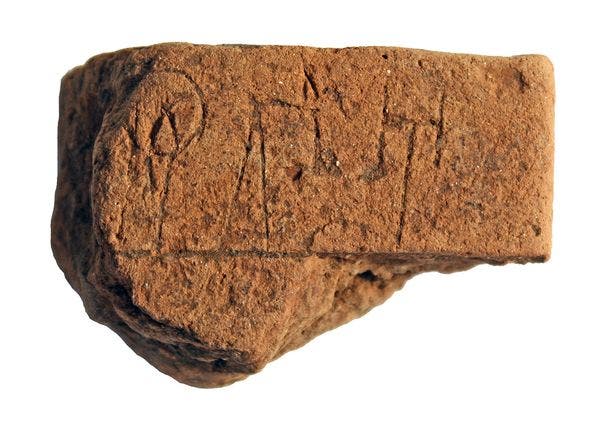
A 3500 years old Mycenaean tablet found last summer in Greece is the oldest form of writing found in Europe. (c) Christian Mundigler
Extraordinary enough, an ancient Greek tablet dating far as back as 1450-1350 BC was found last summer in an olive grove in what’s now the village of Iklaina, which makes it the oldest readable piece of writing found in Europe. The position and time frame of the artifact places it in the time of the Mycenaean, often mentioned in Homer’s Illiad, who ruled much of ancient Greece between 1600 to 1100 B.C.
In the ruins of Iklaina, so far archeologists have found a palace, murals, fortified walls and this highly valuable tablet, most probably written by a local scribe. The tablet is roughly 1 inch ( 2.5 centimeters) tall by 1.5 inches (4 centimeters) wide, and has markings evident of the ancient writing Greek writing system known as Linear B, which consisted of about 87 signs, each representing one syllable.
According to lead archeologists of the project Michael Cosmopoulos, the tablet is definitely the biggest surprise they could have stumbled upon.
“According to what we knew, that tablet should not have been there,” the University of Missouri-St. Louis archaeologist told National Geographic News.
First, Mycenaean tablets weren’t thought to have been created so early, he said. Second, “until now tablets had been found only in a handful of major palaces”—including the previous record holder, which was found among palace ruins in what was the city of Mycenae.
Although the tablet is dated as being 3500 years old, it was made out of clay and clearly never meant to last. Archeologists theorize that on the tablet fiscal related data intended for the elites’ records were scribbled, basically paper work junk, which was put in the sun to dry and then thrown in a pit as trash when it wasn’t needed. Although researchers didn’t have too much markings to read and interpret, they could tell that the front of the Iklaina tablet appears to form a verb that relates to manufacturing, the researchers say, while the back lists names alongside numbers—probably a property list.
“Those tablets were not baked, only dried in the sun and [were], therefore, very brittle. … Basically someone back then threw the tablet in the pit and then burned their garbage,” Cosmopoulos said. “This fire hardened and preserved the tablet.”
While the Iklaina tablet is an example of the earliest writing system in Europe, other writing is much older (writing in China, Mesopotamia and Egipt are thought to date back from 3,000 B.C.) , explained Classics professor Thomas Palaima, who wasn’t involved in the study, which is to be published in the April issue of the journal Proceedings of the Athens Archaeological Society.









